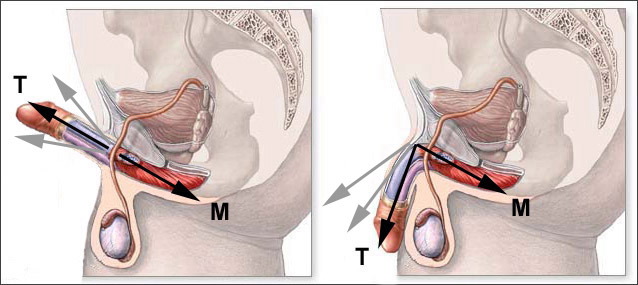beenthere - I’ve never really sat down and examined the whole thing, but you’re right that my knowledge of anatomy is the reason I have doubts that LOT means much. When determining the LOT number you are instructed to “tug” your flaccid penis. In other words, you do a Kegel. In men the muscle used for the Kegel exercise is the bulbocavernosus/bulbospongiosus (Damn you Tube, now I have to use both!). This muscle surrounds the base of the “inner penis.” It is at a fixed point in the pelvis because it is suspended on the two sides from the pelvic bone (the ischiopubic ramii) and at the back (toward the anus) with ligaments. The base of the penis, then, is at a constant angle within the pelvis and cannot move. By doing the tug while pulling out on the flaccid penis, you are basically determining the angle at which the base of your penis sits within your pelvis.
I can’t imagine that this angle varies much from man to man. There certainly is a range, but could the difference be more than about 20-25 degrees? Because of the angle of entry into a vagina, either from the front (missionary) or the back (doggy) the penis must be at an upward angle to the man’s body. At maximum erection and supposing a non-curved penis, the shaft should be in line with the base of the penis within the pelvis. Obviously at other times the angle of erection can vary widely, even though the penis base remains at it’s constant angle within the pelvis.

When attempting to determine the LOT number you are instructed to begin by pulling the flaccid penis straight up (12 o’clock) and move down toward 6 o’clock while doing Kegels. As the BC/BS muscle contracts (M in the illustration) and you tug against it (T in the illustration) any angle of tug that is nearly in line with the angle of the base, or higher, (left side of attached image) will show a strong tug. As you move down past the base angle (right side of image) the tug will be felt and seen less. The muscle contraction doesn’t change, it is just as strong, but you feel and see the tug-back less at the lower angles because you are no longer pulling “in line” with the muscle.
OK. So what? Since the angle is fairly constant, or within a small range, for most men, why try to determine the exact angle (represented as a number on a clock)? What difference would a LOT of 11 and a lot of 9 mean? The basic anatomy would tell you that pulling down will stretch the suspensory and fundiform ligaments and pulling out or up will stretch the tunica. I never understood why such a big deal was made of the specific numbers.
